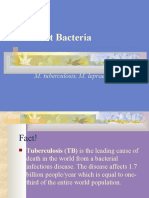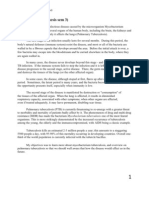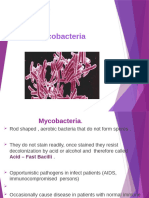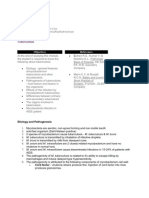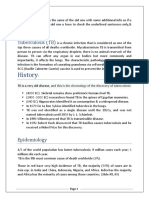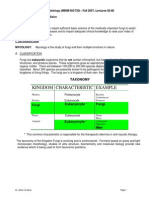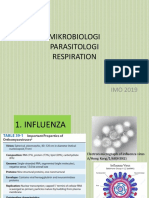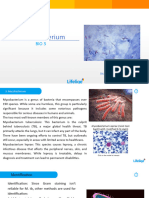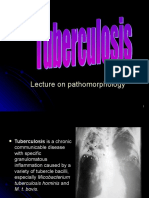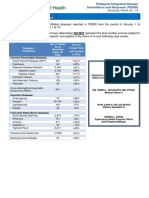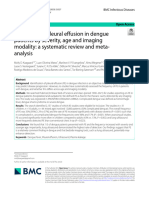My Co Bacterium
My Co Bacterium
Uploaded by
Mukiibi MosesCopyright:
Available Formats
My Co Bacterium
My Co Bacterium
Uploaded by
Mukiibi MosesCopyright
Available Formats
Share this document
Did you find this document useful?
Is this content inappropriate?
Copyright:
Available Formats
My Co Bacterium
My Co Bacterium
Uploaded by
Mukiibi MosesCopyright:
Available Formats
Course: Medical Microbiology, PAMB 650/720 Lecture 43: Mycobacteria /Corynebacteria and Legionellae
2006/2007
Faculty: Dr. Fox, Phone: 733 3288, E-mail: afox@med.sc.edu, Office: C-19, Blg. 2 Suggested reading: Murray, Fifth Edition Chapter 29 (Mycobacteria) Chapter 27 (Corynebacterium diphtheriae) and Chapter 38 (Legionella) Key words Acid Fast Tuberculosis M. tuberculosis M. avium-M. intracellulare complex M. leprae M. bovis Atypicals Tubercle PPD Tuberculin Mycobactin Cord factor BCG Leprosy (Hansen's Disease) Runyon groups Mycolic acids Diphtheria C. diphtheriae Loeffler's agar Tellurite agar Metachromatic bodies Diphtheria toxin Schick test Diphtheroids Legionella pneumophila Legionnaires disease Pontiac fever Legionella micdadei Pittsburg pneumonia Charcoal yeast extract agar
MYCOBACTERIA In the 1980's many experts felt that the days of tuberculosis (TB, consumption) as a threat to the US had passed and the incidence of new cases (<20,000 a year) was slowly decreasing. However, TB remains the leading infectious cause of death world-wide. The situation in the 1990's in the US changed dramatically. The incidence of tuberculosis has slightly increased and certainly the disease is not going away (primarily due to the AIDS epidemic). At the same time multiple drug-resistant strains of M. tuberculosis have appeared. The M. avium-M. intracellulare complex (often simply referred to as M. avium), long considered a group of organisms that only rarely infects man, is now recognized as one of the leading opportunists associated with AIDS. M. leprae is the causative agent of leprosy which remains a major disease in the third-world. Due to eradication of infected cattle and pasteurization of milk M. bovis (a zoonotic cause of tuberculosis) is rarely seen in the US. Mycobacteria are obligate aerobic, acid-fast rods.
M. tuberculosis Pathogenesis of tuberculosis The organism primarily infects the lung, but is distributed systemically within macrophages and survives intra-cellularly. Inhibition of phagosome-lysosome fusion and resistance to lysosomal enzymes occur. Cell mediated immunity develops which causes infiltration of macrophages and lymphocytes with development of granulomas (tubercles). The disease can be diagnosed by skin testing for delayed hypersensitivity with tuberculin (protein purified derivative, PPD). A positive test does not indicate active disease; merely exposure to the organism. Other pathogenesis factors (of considerably less importance than delayed hypersensitivity) include mycobactin (a siderophore) and cord factor that damages mitochondria. Diagnosis, Identification and treatment The presence of acid-fast bacteria in sputum is a rapid presumptive test for tuberculosis. Subsequently, when cultured, M. tuberculosis will grow very slowly producing distinct non-pigmented colonies (2 weeks or so currently). M. tuberculosis can be differentiated from most other mycobacteria by the production of niacin. A rapid alternative to culture is polymerase chain amplification. Tuberculosis is usually treated for extensive time periods (9 months or longer) since the organism grows slowly and may become dormant. By using two or more antibiotics (including rifampin, isoniazid, ethionamide and ethambutol) the possibility of resistance developing during this extended time is minimized. M. tuberculosis causes disease in healthy individuals and is transmitted man-man in airborne droplets. Vaccination The BCG vaccine (Bacillus de Calmette et Guerin, an attenuated strain of M. bovis) has not been effective. In the US, where the incidence of tuberculosis is low, widespread vaccination is not practiced. Indeed immunization (resulting in a positive PPD test) is felt to interfere with diagnosis. M. leprae M. leprae is the causative agent of leprosy (Hansen's Disease) a chronic disease often leading to disfigurement. Rarely seen in the US but common in the third world. The organism infects the skin, because of its growth at low temperature. It also has a strong affinity for nerves. In "tuberculoid" leprosy there are few organisms due to control by active cell mediated immunity. In "lepromatous" leprosy, due to immuno-suppression by the organism, the opposite is found. Although uncommon in the U.S. millions of cases occur worldwide. Treatment with 2
antibiotics (initially dapsone and now multi-drug) is effective and the overall disease incidence worldwide is down. The organism does not grow in lifeless media. However, it grows well in the armadillo (which has a low body temperature), allowing production of M. leprae antigens and pathogenesis studies. M. leprae has traditionally been identified on the basis of acid-fast stains of skin biopsies and clinical picture. Lepromin is used in skin testing.
Atypicals The "atypicals" generally infect the immuno-compromised host and are thus not transmitted man-man. With the AIDS epidemic the atypical mycobacteria have taken on new importance with the recognition that the M. avium complex (MAC) are the most commonly associated systemic bacterial infection. Atypical mycobacteria can cause tuberculosis-like or leprosy-like, diseases, and are not susceptible to certain common anti-tuberculous antibiotics. M. tuberculosis, M. avium and AIDS M. avium generally infects AIDS patients when their CD4 (helper T cell) count decreases greatly (below 100/mm3). M. tuberculosis infects AIDS patients much earlier in the disease than M. avium. This clearly demonstrates the much greater virulence of M. tuberculosis. The incidence of systemic disease (versus primarily pulmonary) is much greater in tuberculosis associated with AIDS than in it's absence. Furthermore, histologically lesions often appear lepromatous (non-granulomatous with many organisms). It is rare to find a case of M. avium infection that is not AIDS associated. Approximately 20% of the total tuberculosis cases in the country are associated with AIDS. This helps explain why TB is no longer on the decline. Treatment of M. avium also involves a long-term regimen of multiple drug combinations. However, this organism does not always respond to the regimens used to treat M. tuberculosis. Since M. tuberculosis is the more virulent organism the drug regimen selected is primarily against M. tuberculosis. If M. avium is suspected other agents effective against this organism are included. Other atypicals Presence or absence of pigmentation (and its dependence on growth in the light) and slow or fast growth rates of atypical mycobacteria allow some differentiation - the "Runyon Groups". Modern techniques allow ready speciation of mycobacteria based on their cellular fatty acid and/or mycolic acid profiles. This is only performed in reference laboratories. Genetic tests are taking over here as elsewhere. Mycolic acids are components of a variety of lipids found only in mycobacteria, nocardia and corynebacteria. The chain length of these mycolic acids is longest in mycobacteria, intermediate in nocardia and shortest in corynebacteria. This explains why mycobacteria are generally acid fast; nocardia less acid fast; and corynebacteria are non-acid fast.
CORYNEBACTERIUM DIPHTHERIAE Grows best under strict aerobic conditions, a Gram positive rod that is pleomorphic (e.g. club-shaped). Colonization of the upper respiratory tract (pharynx and nose) and less commonly skin with C. diphtheriae leads to diphtheria. The organism does not produce a systemic infection. However, in addition to a pseudo-membrane being formed locally (which can cause chocking) systemic and fatal injury results primarily from circulation of the potent exotoxin (diphtheria toxin). The latter begins over a period of a week. Thus treatment involves rapid therapy with anti-toxin. Treatment in these non-immune individuals also involves injection of antibiotics. The gene for toxin synthesis is encoded on a bacteriophage (the tox gene). Corynebacteria, not infected with phage, thus do not generally cause diphtheria. Diphtheria is now a disease of almost historic importance in the US due to effective immunization of infants (in conjunction with pertussis and tetanus, DPT) with a toxoid (inactive toxin) that causes production of neutralizing antibodies. However, colonization is not inhibited and thus C. diphtheriae is still found in the normal flora (i.e. a carrier state exists). If we let our guard down and dont vaccinate diphtheria will come back. Immunity can be monitored with the Schick skin test, observing the ability to neutralize toxin. Diphtheria toxin is an A-B exotoxin. Binds to epidermal growth factor (the receptor) on host cells; and then the A component becomes internalized and inhibits protein synthesis. This receptor is common in cells of the heart and lung, explaining why these sites are particularly affected. The exotoxin catalyses the covalent attachment of the ADP-ribose moiety of NADH to a rare amino acid, diphthamide, present in EF2 (elongation factor 2). The toxin is not synthesized in the presence of iron as an iron-repressor complex forms that inhibits expression of the tox gene. C. diphtheriae are identified by growth on Loeffler's medium followed by staining for metachromatic bodies (polyphosphate granules, Babes-Ernst bodies). The term "metachromatic" refers to the color difference of the intracellular polyphosphate granules (pink) compared to the rest of the cell (blue). Characteristic black colonies are seen on tellurite agar from precipitation of tellurium on reduction by the bacteria. Production of exotoxin can be determined by in vivo or in vitro tests. Other organisms that morphologically resemble C. diphtheriae ("diphtheroids" which include other corynebacteria and also propionibacteria) are found in the normal flora. Isolates should not be confused with these organisms. LEGIONELLAE In 1976/77, Legionella pneumophila was recognized as a newly described pathogen after an investigation by the Centers for Disease Control (CDC) of an outbreak of pneumonia, with several fatalities, among a group of Legionnaires at a convention. The disease was subsequently referred to as Legionnaires disease. Another milder self-limiting form of the disease (primarily 4
characterized by myalgia [muscle pain]) but no pneumonia is referred to as Pontiac fever. Quickly L. pneumophila filled the world stage as a major pathogen and as rapidly as interest appeared it waned within the next 10 years; probably, because legionellosis was found to be treatable with erythromycin. Occasional small epidemics of Legionnaire's disease in apparently healthy people still occur. However, the organism is more frequently observed in sick or elderly individuals whose immune responses may be compromised. This particularly occurs in the hospital setting. The causative agent was not recognized previously, since it does not grow on conventional agar such as sheep blood agar. Nowadays L. pneumophila is cultured on media that contains iron and cysteine vital for growth. However primary isolation is still difficult from clinical specimens. The organism stains poorly as a Gram negative rod. Some legionellae (including L. micdadei) also stain slightly acid fast. However, they are NOT genetically related to mycobacteria. Legionella pneumophila is an organism that resides in the environment in pools of stagnant water. It is found as an intracellular agent within protozoa. In man it also survives as a facultative intracellular pathogen. It often infects hot water towers and air conditioning systems. Heat shock proteins are involved in heat survival. Indeed it is the only bacterial agent whose presence is of major concern in indoor air quality. When found in buildings, anti-bacterial treatment of the water supply is recommended. The organism is transmitted in contaminated air but not spread person-person. After recognition of their unique culture characteristics, a large number of other species of Legionella were isolated from environmental and clinical samples. These organisms are only occasional causes of human disease and the vast bulk of legionellosis is caused by Legionella pneumophila (most are serogroup 1). The second most common is Legionella micdadei. The "hot" period of study of these organisms was when it was no longer popular to study bacteria using conventional physiological means. The techniques of fatty acid profiling and DNA-DNA hybridization had just been introduced and were in wide use at the CDC and elsewhere. 16S rRNA sequence analysis has sorted out much of the taxonomy of this group of organisms. However, the techniques are far too complex for routine use in the clinical laboratory. Probes have been used to detect L. pneumophila in clinical specimens and commercial PCR tests are available. Another technique detects the Legionella lipopolysaccharide antigen in urine. Serology is also employed. However, all approaches (including culture) have limited sensitivity in clinical specimens. The clinical importance of this organism is thus difficult to judge.
You might also like
- HCD 3226 Mycobacteria and CorrynebacteriaDocument11 pagesHCD 3226 Mycobacteria and Corrynebacteriarodipo80No ratings yet
- PharmaDocument13 pagesPharmajammieyosraNo ratings yet
- Mycobacterium TuberculosisDocument17 pagesMycobacterium TuberculosisKate Anya Buhat-DiesmaNo ratings yet
- Prepared By:-Kishor R. LalchetaDocument56 pagesPrepared By:-Kishor R. Lalchetakishor.lalchetaNo ratings yet
- Benito K. Lim Hong III, M.DDocument55 pagesBenito K. Lim Hong III, M.DCoy NuñezNo ratings yet
- Tuberculosis: Mechanism and TherapyDocument6 pagesTuberculosis: Mechanism and TherapyHyeong Ghil ShinNo ratings yet
- Mycobacterium Tuberculosis and Tuberculosis - TodarDocument18 pagesMycobacterium Tuberculosis and Tuberculosis - TodarTanti Dewi WulantikaNo ratings yet
- Acid Fast Bacteria: M. Tuberculosis, M. LepraeDocument22 pagesAcid Fast Bacteria: M. Tuberculosis, M. LepraeelaNo ratings yet
- Mycobacterium Tuberculosis: Presented By: Haneen Oueis, Suzanne Midani, Rodney Rosfeld, Lisa PettyDocument26 pagesMycobacterium Tuberculosis: Presented By: Haneen Oueis, Suzanne Midani, Rodney Rosfeld, Lisa PettyFransiscaPermataNo ratings yet
- MycobacteriumDocument14 pagesMycobacteriumSnowie BalansagNo ratings yet
- Thesis DoneDocument24 pagesThesis DoneAmira SaidinNo ratings yet
- Tuberculosis: Therapeutics IIDocument54 pagesTuberculosis: Therapeutics IIdstu20No ratings yet
- Mircrobiology Lecture - 17 MycobacteriaDocument63 pagesMircrobiology Lecture - 17 MycobacteriaChris QueiklinNo ratings yet
- MT bacteria-1 م٥Document25 pagesMT bacteria-1 م٥bvmg8vh9xdNo ratings yet
- 14 MycobacteriumDocument9 pages14 MycobacteriumAfradhRasheedNo ratings yet
- Chapter 56Document57 pagesChapter 56Rahmat MuliaNo ratings yet
- SPIROCHETES (Treponema, Borrelia and Leptospira)Document4 pagesSPIROCHETES (Treponema, Borrelia and Leptospira)Muneer Al-DahbaliNo ratings yet
- Micro 5Document51 pagesMicro 5NeviNo ratings yet
- Mycobacterium TuberculosisDocument9 pagesMycobacterium Tuberculosisrecoil nineNo ratings yet
- Assignment On MycobacteriaDocument7 pagesAssignment On MycobacteriaAlamgir HossainNo ratings yet
- Cutaneous Tuberculosis: Epidemiologic, Etiopathogenic and Clinical Aspects - Part IDocument10 pagesCutaneous Tuberculosis: Epidemiologic, Etiopathogenic and Clinical Aspects - Part IDellNo ratings yet
- RITM LeprosyDocument3 pagesRITM LeprosyDanielle Vince CapunoNo ratings yet
- Kuliah TuberkulosisDocument64 pagesKuliah TuberkulosisLeonardNo ratings yet
- Occur Less Frequently Than in Patients With Tuberculosis.: 1 - What Are The Differential Diagnosis of This Case ?Document17 pagesOccur Less Frequently Than in Patients With Tuberculosis.: 1 - What Are The Differential Diagnosis of This Case ?Rana KhalidNo ratings yet
- Tuberculosis EssayDocument16 pagesTuberculosis EssayDineswari RemyndranNo ratings yet
- Document 4Document14 pagesDocument 4karthiksekaranNo ratings yet
- Immune WorksheetsDocument25 pagesImmune Worksheetsjslongmire100% (1)
- Finals Mycobacteria 2Document12 pagesFinals Mycobacteria 2JaneNo ratings yet
- Tuberculosis - StatPearls - NCBI BookshelfDocument10 pagesTuberculosis - StatPearls - NCBI BookshelfDhany karubuyNo ratings yet
- Corynebacterium Diphtheriae (Jawetz Translated)Document11 pagesCorynebacterium Diphtheriae (Jawetz Translated)Fariza HasyatiNo ratings yet
- Acid Fast Bacilli (Mycobacterium Tuberculosis)Document28 pagesAcid Fast Bacilli (Mycobacterium Tuberculosis)yabais110No ratings yet
- Problem Case Tuberculosis)Document6 pagesProblem Case Tuberculosis)caltzxNo ratings yet
- Lecture 17Document31 pagesLecture 17Me TooNo ratings yet
- Mycobacterium LectureDocument39 pagesMycobacterium LectureDegee GonzalesNo ratings yet
- Diagnosis and Treatment of TBDocument10 pagesDiagnosis and Treatment of TBatefghonaim94No ratings yet
- Patogenesis TBDocument46 pagesPatogenesis TBJaya Semara PutraNo ratings yet
- Mycobacterium TuberculosisDocument8 pagesMycobacterium TuberculosisDoru RusuNo ratings yet
- Finals Mycobacteria 2Document14 pagesFinals Mycobacteria 2JaneNo ratings yet
- HealthDocument3 pagesHealthJustine MasagnayNo ratings yet
- Opportunistic MycosesDocument7 pagesOpportunistic MycosesAbhishek ChandraNo ratings yet
- Infectious Diseases (1&2) : TuberculosisDocument67 pagesInfectious Diseases (1&2) : TuberculosisYesi SaputriNo ratings yet
- History: Tuberculosis (TB)Document24 pagesHistory: Tuberculosis (TB)Rashed ShatnawiNo ratings yet
- TuberculosisDocument42 pagesTuberculosisGilbertoMpakaniyeNo ratings yet
- Bordetella: Bordetella Organisms Are Small, Gram-Negative Coccobacilli Which Are Strict Aerobes. The ThreeDocument7 pagesBordetella: Bordetella Organisms Are Small, Gram-Negative Coccobacilli Which Are Strict Aerobes. The ThreeFlor OMNo ratings yet
- MYCOLOGYDocument33 pagesMYCOLOGYiwennieNo ratings yet
- Mycobacterium Tuberculosis:: 1. Pulmonary Disease 2. Extra-Pulmonary Disseminated DiseaseDocument3 pagesMycobacterium Tuberculosis:: 1. Pulmonary Disease 2. Extra-Pulmonary Disseminated Diseasesmart_dudeNo ratings yet
- Mikrobiologi Parasitologi Respiration: AN IMO 2019Document64 pagesMikrobiologi Parasitologi Respiration: AN IMO 2019Sleeping BeautyNo ratings yet
- SSMJ Vol 6 1 Tuberculosis PDFDocument3 pagesSSMJ Vol 6 1 Tuberculosis PDFLiviliaMiftaNo ratings yet
- MycobacteriaDocument26 pagesMycobacteriacimdesadesuNo ratings yet
- Finals MycobacteriaDocument15 pagesFinals MycobacteriaJaneNo ratings yet
- 10 Infectious Diseases TB SDocument134 pages10 Infectious Diseases TB SPrakhar TiwariNo ratings yet
- TuberculosisDocument15 pagesTuberculosiscoeta23277No ratings yet
- Main 1Document10 pagesMain 1Adianto Jaya Nagara, drNo ratings yet
- Portalwp-Contentuploads201906manual Recomendacoes TB 2ed Atualizada 8maio19.PDF 3Document10 pagesPortalwp-Contentuploads201906manual Recomendacoes TB 2ed Atualizada 8maio19.PDF 3ktichaNo ratings yet
- Case Study: Pulmonary TuberculosisDocument28 pagesCase Study: Pulmonary TuberculosisKrizzia Mae F. MayoresNo ratings yet
- Mycobacterium AngelDocument7 pagesMycobacterium AngelYuri YuriNo ratings yet
- Lecture On PathomorphologyDocument70 pagesLecture On PathomorphologyEdi Kerina SembiringNo ratings yet
- Student Project (Unedit)Document32 pagesStudent Project (Unedit)vikaNo ratings yet
- Tuberculosis A Forgotten Foe With A Dangerous PropositionDocument7 pagesTuberculosis A Forgotten Foe With A Dangerous PropositionScivision PublishersNo ratings yet
- Botany 4Document6 pagesBotany 4Upadhyay HarshitNo ratings yet
- Kirby-Bauer (Antibiotic Sensitivity)Document3 pagesKirby-Bauer (Antibiotic Sensitivity)Gutierrez AliNo ratings yet
- Safety Seal Certification Checklist: Department of The Interior and Local GovernmentDocument2 pagesSafety Seal Certification Checklist: Department of The Interior and Local GovernmentBarangay CentroNo ratings yet
- 15 Impressive Herbs With Antiviral ActivityDocument6 pages15 Impressive Herbs With Antiviral ActivityerinaNo ratings yet
- Food Safety Inservice PresentationDocument17 pagesFood Safety Inservice Presentationlen77728247No ratings yet
- Global Vector Control Response 2017-2030: Fourth Draft (Version 4.3)Document50 pagesGlobal Vector Control Response 2017-2030: Fourth Draft (Version 4.3)Febby WadoeNo ratings yet
- Influenza Vaccine: What You Need To KnowDocument2 pagesInfluenza Vaccine: What You Need To Knowapi-237098034No ratings yet
- Multiple Drug ResistanceDocument14 pagesMultiple Drug ResistanceHarsh ChopraNo ratings yet
- Paediatric HIV Infection by DR A.K.Gupta, Additional Project Director, Delhi State AIDS Control SocietyDocument88 pagesPaediatric HIV Infection by DR A.K.Gupta, Additional Project Director, Delhi State AIDS Control Societydr.a.k.gupta6924No ratings yet
- "Contagion" Film Analysis Name: Diestro, Angela Mae Section: BSN 1 BDocument4 pages"Contagion" Film Analysis Name: Diestro, Angela Mae Section: BSN 1 Bangela Mae Diestro50% (2)
- 2020 PIDSR WeeklDocument1 page2020 PIDSR WeeklErrol LlanesNo ratings yet
- Basic Protocols in Handling The Slms For Delivery, Distribution and RetrievalDocument1 pageBasic Protocols in Handling The Slms For Delivery, Distribution and RetrievalBai NorieneNo ratings yet
- Timor Leste Strategic Plan 2021-20230Document94 pagesTimor Leste Strategic Plan 2021-20230BBB cccNo ratings yet
- XXXXXXXXXXX BGDocument5 pagesXXXXXXXXXXX BGProbioticsAnywhereNo ratings yet
- 571 - Immunization QuizDocument8 pages571 - Immunization QuizMichelle Dinser100% (4)
- Group Name 2 English ClubDocument10 pagesGroup Name 2 English ClubWill HensNo ratings yet
- Pyogenic Staphylococcal & Streptococcal InfectionsDocument24 pagesPyogenic Staphylococcal & Streptococcal InfectionsFY MicroNo ratings yet
- Keys 10,11Document2 pagesKeys 10,11Micaela VazquezNo ratings yet
- Vaccination 710428115244Document1 pageVaccination 710428115244arleesyaNo ratings yet
- Health Center Monitoring SheetDocument3 pagesHealth Center Monitoring SheetFret Ramirez Coronia RNNo ratings yet
- Coronavirus (COVID-19) RecordsDocument1 pageCoronavirus (COVID-19) RecordsMohammad Tayyab KhanNo ratings yet
- Combined PDF VersionDocument9 pagesCombined PDF Versionmoha.taqiiNo ratings yet
- Penagihan Dadah, Seks Bebas Dan TranseksualDocument76 pagesPenagihan Dadah, Seks Bebas Dan TranseksualezzatulNo ratings yet
- Frequency of Pleural Effusion in Dengue Patients by Severity, Age and Imaging Modality: A Systematic Review and Meta-AnalysisDocument9 pagesFrequency of Pleural Effusion in Dengue Patients by Severity, Age and Imaging Modality: A Systematic Review and Meta-AnalysisSania AzaliaNo ratings yet
- Student - Module 1Document31 pagesStudent - Module 1Emerlinda OlivaNo ratings yet
- My Realization in Our Country in This Time of Pandemic Is We Are Not Prepared For This Kind of Calamity in Fact All The Country Around The World Was Surprised and Was Not Able To Take The PreDocument2 pagesMy Realization in Our Country in This Time of Pandemic Is We Are Not Prepared For This Kind of Calamity in Fact All The Country Around The World Was Surprised and Was Not Able To Take The PreChristian Dave RoneNo ratings yet
- Masterlist For Sbi Ihcp Wifa Sy 2021 2022Document3 pagesMasterlist For Sbi Ihcp Wifa Sy 2021 2022Eloisa BinuyaNo ratings yet
- Nini Micro AssignmentDocument3 pagesNini Micro Assignmentaubrey yangzonNo ratings yet
- HPH-108 Environmental Health ParasitologyDocument3 pagesHPH-108 Environmental Health Parasitologynevil moraraNo ratings yet
- Prevention of Dialysis Acces Cath Related InfectionDocument33 pagesPrevention of Dialysis Acces Cath Related Infectionbarkah04No ratings yet







